|
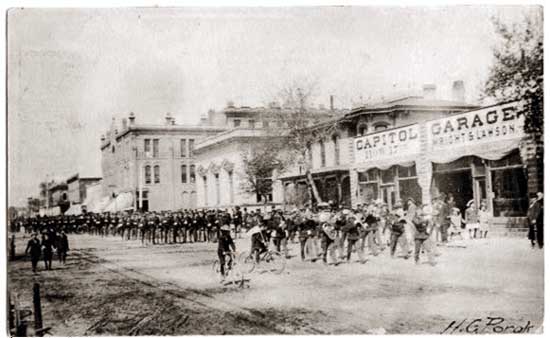
Grand Army of the Republic Memorial Day Parade, 1908. 17th Sreet looking west, Opera House on the corner past the Stockgrower's Bank
building. The Woodmen of the World provided the band.
Participating in the parade depicted above, in addition to the GAR, were the Army and Navy Union, Spanish War Veterans and the Cheyenne Fraternal battalion.
The Fraternal Battalion consisted of the respective drill teams of the Cheyenne Canton No. 1 of the
Odd Fellows, the Uniform Rank of the Knights of Pythias, the Modern Woodmen of America, the Woodmen of
the World, and the Royal Highlanders. As an indication that the old animosities had faded, Confederate veterans were invited to participate. The parade proceeded east on
17th Street and thence to the Catholic Cemetery where a memorial to the veterans was dedicated. Indeed,
the animosities had died. In 1895, former Confederate Major General Joseph Wheeler attended the Grand Army of the Republic Memorial Day ceremony in Boston. Following the
singing of the Battle Hymn of the Republic, he was introduced as the post organist played Dixie to the cheers of
the veterans present. In 1903, the Gettysburg Post of the GAR played, according to the Charlotte, N.C. Observer, Dixie
"with as much spirit as if it was played in Charlotte." In 1915, during the Grand Review before President Wilson,
members of the Grand Army in addition to Union songs such as "Maryland, My Maryland" and the GAR Closing Ode, sang "Dixie."
The Modern Woodmen of America and the Woodmen of the World were primarily organzed as insuance benevolent societies. Both were organized by Joseph Cullen Root along the
lines of a fraternal order, complete with ritual and social aspects. Both organizations of Woodmen had drill teams who also conducted the
initiations. The Royal Highlanders also was an insurance benevolent society organized as a fraternal order in 1896 in Nebraska by F. J. Sharp and W. E. Sharp.
Lodges were called
"castles." At one point the order had castles in Cheyenne, Lusk, Evanston and Sheridan. Cheyenne Castle No. 529 was instituted in January of 1908 and held its
first grand ball in Keefe Hall on Eddy Street.
The officers of a local castle included the Illustrious Protector, the chief Archer, the Chief Spearsman, the Worthy Warder, th Worthy Evangel, and the Guard. Members
were called "Clansmen." The secret initiatory ritual
was based on the life of William Wallace and Robert the Bruce. Its badge included the symbols of
the Thistle, the Cross, and the Heart of Bruce. The opening ode sang at the beginning of each meeting:
Within Our Castle good and strong.
We meet with Clansmen dear.
With Joyous hearts we raise out song
of Hearty Highland cheer.
Each Chief and Clansman in his place,
with Shields and banners bright.
We're glad to see each welcome face
Within our hall to-night.
The "Executive Castle" in Nebraska from which the insurance operations were conducted was
alleged modeled after Balmoral Castle. Any resemblance was purely coincidental. The degree teams were attired in
Kilts, sporan, etc. The Nebraska courts held that any resumblance between the Royal Highlanders and a true benevolent sociey was
also coincidental, its main purpose was the sale of insurance. See Royal Highlanders v. State, 108 N.W. 183 (Neb. 1906).
In 1923, the order gave up the pretense of being a fraternal order and merged with the Lincoln Mutual Life Insuance Company.
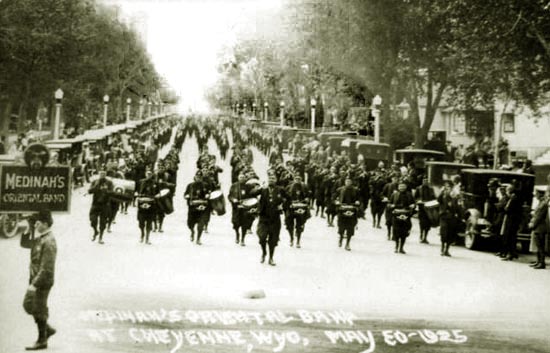
Medinah's Shrine Band, Memorial Day Parade, Cheyenne 1925.
Medinah Shrine was from Chicago. Memorial Day was instituted by the Grand Army of the Republic which at one time had over a half million members. Grand Army Posts in Wyoming were located
throughout the state. Department of Colorado and Wyoming Post No. 1, Custer Post, was located in
Laramie. J. F. Reynolds Post No. 33 in Cheyenne was instituted in 1881 with 100 members. Other posts were located in
Lander, Evanston, Rawlins, Sundance, Buffalo, Rock Springs,
Buffalo, Rock Springs, Tie Siding, Newcastle, and Sheridan.
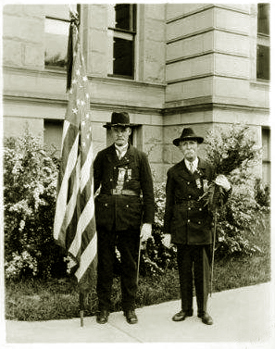 Arthur A. Mahan and Thomas A. Castle, J. F. Reynolds Post No. 33, Department of Colorado and
Wyoming, Grand Army of the Republic, Memorial Day, 1914. Photo by Joseph Shimitz. Arthur A. Mahan and Thomas A. Castle, J. F. Reynolds Post No. 33, Department of Colorado and
Wyoming, Grand Army of the Republic, Memorial Day, 1914. Photo by Joseph Shimitz.
Following the Spanish American War, the decision was made
by the Grand Army that it would not admit veterans of that war and that membership would continue to be limited to
veterans who served in the Union Armies during the Civil War. By 1910, the Cheyenne Post was reduced to 38 members, C. W. Collins Post No. 58 in Rawlins to 25 members, and Thos.
A. McCoy Post No. 34 in Lander to only 10 members. The Cheyenne Memorial Day Parade in 1910 was led by 78 year-old Major John Talbot who was
still regarded as a good horseman. Several weeks following the parade, Talbot fell from a street
car and died apparently of a sub-dural hemotoma. By 1916, the last member of the Rawlins Post had answered the last roll call.
By 1924, the Drum Corps of the U. S. Grant Post of Chicago consisted of one surviving member. In 1939, the Departmental encampment for
Colorado and Wyoming was combined with that of the Veterans of Foreign Wars in Cheyenne. Thomas A. Castle, Co. B, 132nd Pa. Volunteers, was given an
honorary membership in the Veterans of Foreign Wars. On May 12, 1940 the Boulder, Colorado, Post of the Grand Army, the last active post of the
Department of Colorado and Wyoming, became inactive. Two years later, in 1943, T. A. Castle of Cheyenne answered his final roll call.
On August 9, 1948, Robert T. Byran, the last member of the Grand Army of the Republic in the Department of Colorado and Wyoming joined his comrades in
the Final Reunion. The
Great Book containing the service records of members of the Department of Colorado and Wyoming was closed. The Great Book along with the
Departmental Charter is now in a museum in Colorado Springs. The Charter for J.F. Reynolds Post No. 33 and T. A. Castle's honorary membership in the
Veterans of Foreign Wars are now held by the Wyoming State Archives.
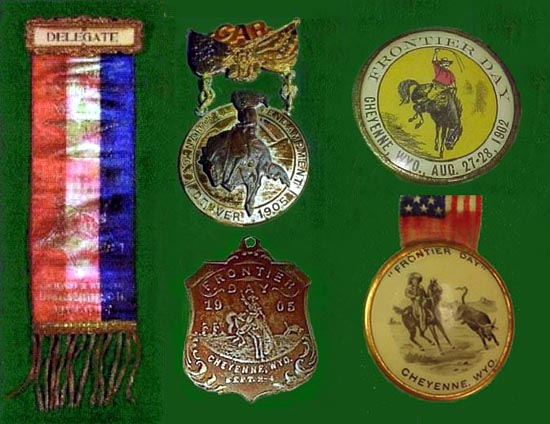
Badges from Cheyenne,
Top Row, left to Right: Grand Army of the Republic Delegates Badge, Department of Colorado and Wyoming Encampment,
Colorado Springs, 1907;
Department of colorado and Wyoming Badge, National Grand Army Encampment, Denver 1905;
Cheyenne Frontier Day badge, 1902;
Bottom Row, Frontier Day Badge, 1905;
Right, Frontier Day Badge, 1902.
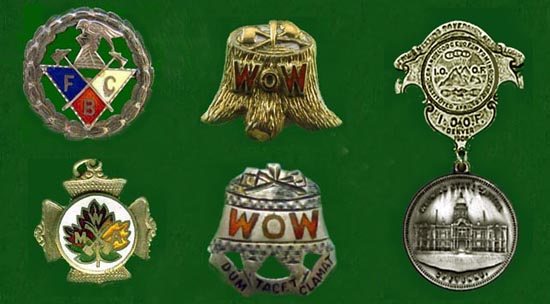
Fraternal Order Badges ,
Top Row, left to Right: Knighs of Pythias,
Center, Woodmen of the World;
End, Cheyenne Canton No. 1, Independent Order of Odd Fellows Badge for Denver National Encampment, 1903,
Bottom left, Modern Woodmen of America; Bottom center Woodmen of the World
The letters. F, C, and B, on the Knights of Pythias Badge denote Friendship, Charity, and Benevolence.
The Latin Motto "Dum Tacet Clamat" on the Woodmen of the World Badge is translated "He claims though he be silent."
Joseph Cullen Root, the founder of the order explained its significance. After one is dead and buried, there is a claim by the decedent to be remembered,
honored, and for his widow to be protected against filching, robbery, and swindling by avaricious lawyers. See
Schleh, G. H., Life and addresses of Joseph Cullen Root: the founder of Woodcraft
Omaha, 1914, p. 121. Root was a lawyer.
Following the end of World War I, veterans of the war formed the American Legion, modeled to a great extent on the
Grand Army of the Republic. The first legion post in the state
and possibly in the nation, was the post in Van Tassell to the east of Lusk. Soon posts were throughout the
state.
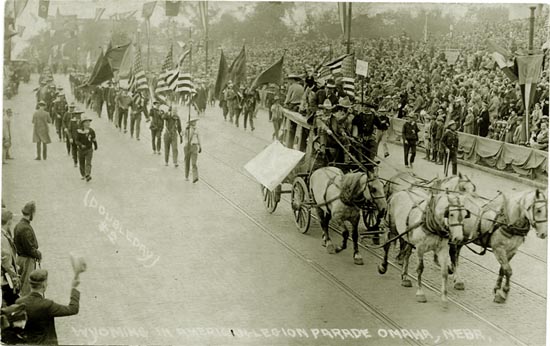
Wyoming Veterans of World War I in American Legion Parade, Omaha,
1923.
And just as the veterans of the Civil War have answered their final
roll call, the veterans of World War I have now joined their final reunion.
The last combat Veteran of World War I, Claude Choules, of the Royal Navy died on May 5, 2011. The last American
veteran Frank Buckles died Feb. 28, 2011. The last seaman who servced on the USS. Wyoming during
World War I, Ernest Pusey, died on November 19, 2006.
Music This Page, Courtesy of Horse Creek Cowboy: Battle Hymn of the Republic and Dixie.
Next page, Cheyenne Transcontinental Airport.
|